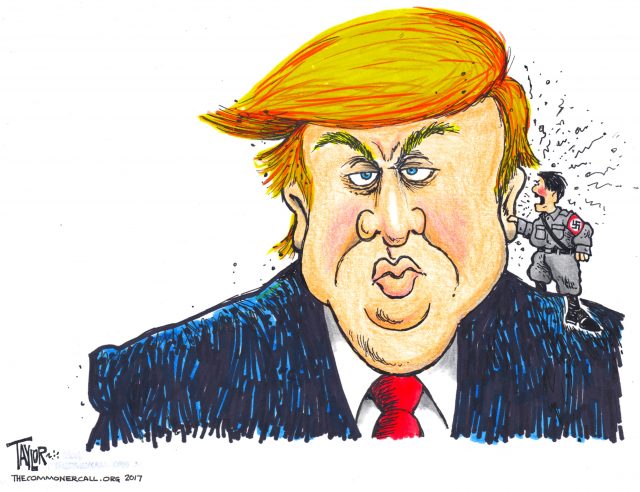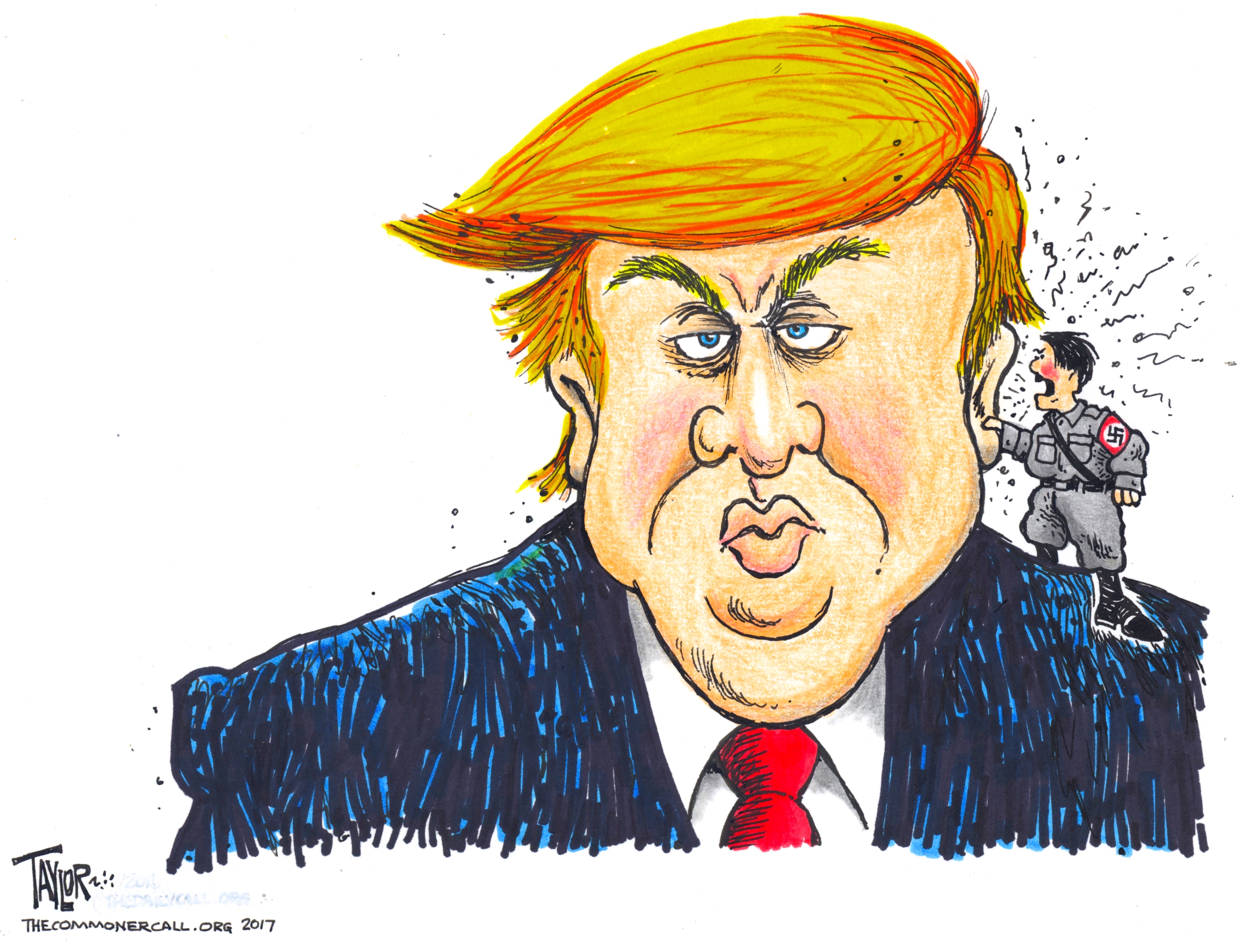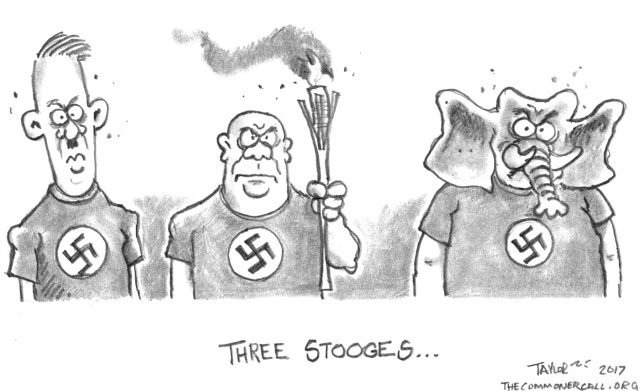
By Richard E. Frankel
History News Network (8/31/17)
In August of 1932, in the town of Potempa, nine Nazi Stormtroopers murdered a supporter of the German Communist Party, kicking him to death in his own apartment as his family watched in horror. Six were convicted with five receiving the death penalty. After the verdict, Hitler sent them a telegram in which he declared to them his “boundless loyalty.” Shortly after he came to power in 1933, he pardoned the killers. While former Sheriff Joe Arpaio never kicked anyone to death, his pardon by President Trump raises disturbing parallels.
Upon gaining power, Hitler immediately pardoned allies who’d perpetrated ghastly crimes against those deemed enemies of the nation. What do we make of Trump’s pardon of a political ally, a man duly convicted of systemic deprivations of people’s constitutional rights—people Trump never considered part of his America? As a professor of modern German history, this administration seemingly provides such unpleasant reminders of Germany’s dark past on a regular basis. What can German history teach us about this latest episode? How, for example, did the pardon of the Potempa killers help us better understand Hitler? What implications did it have for development of the Third Reich? And how does that knowledge help us better understand Trump and the danger that his pardon of Arpaio poses for the future of the United States?
With the German experience we have an example of where things can lead if left unchallenged. What should we take from that experience for our current situation?
Many Americans believe that our long-established legal institutions and traditions will withstand any attempt by Trump to undermine the rule of law. Ours, after all, is a government of laws, not people. But how much comfort should we really take in such traditions? Here, German history provides a frightening lesson. Germans, too, took great pride in the long-established tradition of the Rechtstaat—a state under the rule of law. Here, one may not agree with the law, but one could be confident that it would be applied consistently. What we see with Hitler is his determination to destroy that tradition as well as the remarkable ease and speed with which he was able to do just that.
Führer and law become one
On February 27, 1933, less than one month after Hitler became Chancellor, the Reichstag building erupted in flames. Blaming the Communists, Hitler suspended civil liberties and gave the police extraordinary powers to search and arrest. He then demanded death for suspected arsonist Heinz van der Lubbe. That arson was not a capital offense did not bother him in the least. After some early resistance, the Justice Ministry wrote the Lex van der Lubbe, retroactively allowing for the execution. Within months, the centuries-old Rechtstaatwas giving way to a system in which the law and the will of the Führer were one.
When Hitler pardoned the Potempa killers and persuaded his Justice Ministry to compose the Lex van der Lubbe, he sent two clear messages. First, his pardon of the Potempa killers made clear the boundary of Hitler’s national community. Communists were excluded. The significance of the boundary that separates ‘us’ from ‘them’ is in the value that one places on the lives of those beyond that border. For some, their fate was of no concern. For others, say, Communists or Jews, killing them was, in fact, good. …
*****
Why ‘Just Ignore Them’ Is Really Rotten Advice For Dealing With American Nazi Movement
And the best way to prevent violence is to build solidarity. Ignoring bullying doesn’t make it go away, but organizing the community against it can.
By Molly Knefel
The Rolling Stone (8/31/17)
Since the white supremacist violence in Charlottesville earlier this month, the question of what to do about neo-Nazis, white nationalists and other racists marching in the streets has dominated news cycles. For those who are willing to put their bodies on the line to fight fascism, the answer is unequivocal: These people need to be stopped from gathering in public, from organizing and growing. For decades, anti-fascists have dealt with Nazis by showing up in person to confront them and reduce the harm they can do. But invariably, liberals, moderates and conservatives alike have advocated another approach: Just ignore them. That was the ultimate conclusion of Tina Fey’s “sheetcaking” rant on Saturday Night Live (which made some otherwise smart and critical points). And it’s a sentiment that may sound familiar to anyone who was bullied as a kid.
“For those who could otherwise choose to ignore it, paying attention and showing up is a moral imperative right now – not just to stop these particular Nazis, but to build a culture that teaches young people how to reject violence, rather than perpetuate it.”
“Just ignore them” seems to be adults’ near universal advice to generations of bullied kids. I’m a millennial, and despite our reputation for living our childhoods from one coddled participation trophy to the next, there wasn’t a widespread, organized effort to address and prevent bullying in schools in the United States until after Columbine. It’s been a difficult process for educators to find and implement practices that effectively reduce bullying – in part because, despite how adults talk about it, bullying doesn’t start and stop with kids. But, to the surprise of no one who remembers hearing it themselves, it turns out “just ignore it” is not an effective solution to violence.
I’m an educator, and I understand where “just ignore it” comes from on a kid level. There are plenty of times when kids are engaging in a behavior purely for the reaction they get from the other kid. (This will also sound familiar to siblings.) But for a child who is being bullied, who takes the step of seeking help from an adult, being told to “just ignore it” is a kind of sanctioning of the initial violence. It not only minimizes the harm being done, but validates it. …
Read the Rest
(Commoner Call cartoons by Mark L. Taylor, 2017. Open source and free to use with link to www.thecommonercall.org )


